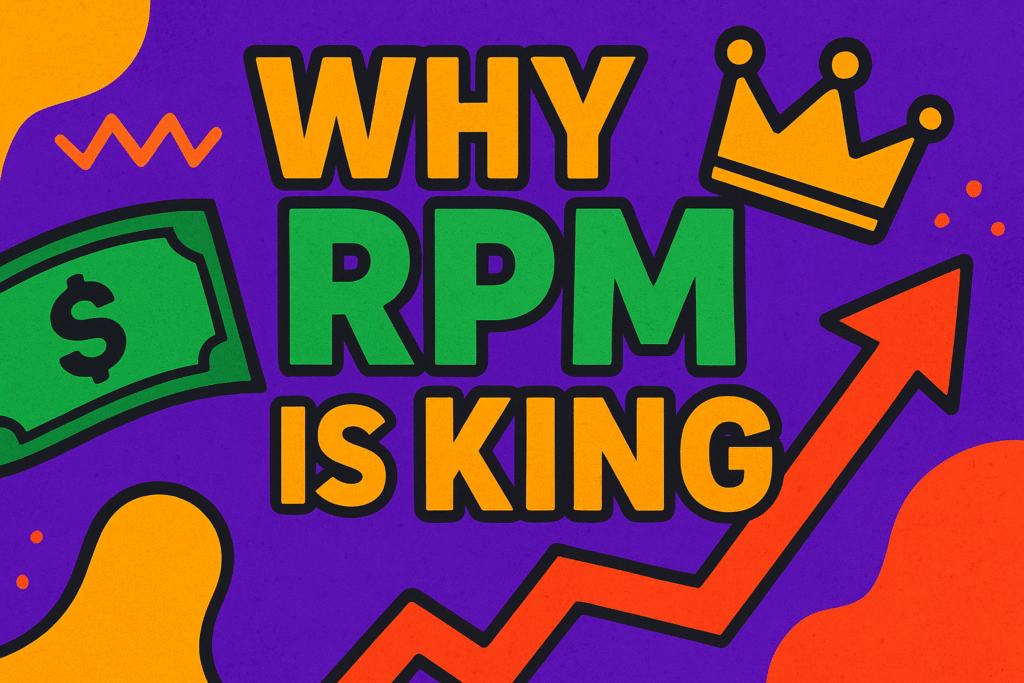Introduction
Ad money can feel random. However, the sites that win follow one rule: optimize for revenue per thousand impressions, or RPM. Because RPM blends page views and earnings, it reveals where value comes from. It gives African publishers a target even when devices, data prices, and demand change by country. If you want stable income, let RPM guide your choices.
What RPM Really Means for African Sites
RPM equals total ad revenue divided by page impressions, multiplied by 1,000. That math shows the value of each thousand views. Yet the number is more than a formula. It is a scoreboard for copy, audience, and tech. For example, a gossip blog can post huge sessions but low RPM because buyers avoid the audience. Conversely, a focused finance site can earn more with fewer readers. Consequently, you should track RPM by post, by category, and by country. Also, separate desktop and mobile because phone screens dominate and ad units behave differently on touch devices.
Maximizing Blog Ads: The RPM Math You Must Know
First, split RPM into price and quantity. Price reflects auction competition for your audience. Quantity reflects how many viewable impressions each visit creates. Additionally, watch two levers: fill rate and viewability. When ads load fast and stay in view, exchanges bid higher. Use AdSense help on RPM for exact definitions. Then connect your ad server to analytics so you can tie RPM to specific pages. Moreover, plot RPM by day and mark design changes, rollbacks, and promotions so you can explain spikes and dips.
Speed, Layout, and Viewability
Speed is money on mobile in Lagos, Accra, and Nairobi. Therefore, compress images, lazy-load embeds, and remove duplicate scripts. Test with PageSpeed Insights, then fix the top items. Keep one unit above the fold on phones. According to the IAB viewability guidelines, an impression counts when 50% of pixels are in view for at least one second on display and two seconds on video. Hence, target stable layouts, steady scroll paths, and fast first input delay.
Traffic Quality Beats Traffic Volume
Bots and cheap clicks sink auctions. Instead, aim for intent. Write for questions buyers ask, not only viral topics. Moreover, prune traffic sources that bounce in seconds. Remove interstitials that break sessions. Next, improve depth with internal links, sidebars that recommend related posts, and clear next steps. Then test content length. On many African networks, a 700-to-1,000-word page with one lead image and tidy HTML outperforms a bloated long read. As quality climbs, demand rises, and RPM follows as advertisers compete for cleaner, higher-intent traffic. Also, use structured data for Articles and FAQs so search results show rich snippets that attract intent.
Geo Strategy and Payment Reality
Advertisers pay different rates by market. Therefore, target high-yield geos without abandoning local readers. For pan-African stories, add pricing, brands, and names that match South Africa, Nigeria, Kenya, and Ghana. Additionally, convert currency and give short context so buyers see relevance fast. Meanwhile, use country-level RPM reporting to spot outliers. If one nation pays twice as much, build landing pages and newsletters for that audience. Also, diversify payment partners to avoid delays. Banks, fintech, and mobile wallets help you survive payout gaps during holidays or bank strikes.
Ad Networks and When to Switch
No network fits everyone. However, the right partner will outbid the rest on your niche and devices. Start with a simple setup, then move to advanced stacks when traffic grows. For small sites, Google AdSense is easy to launch. As sessions rise, test mediation or partners like Ezoic for automated layouts and AI placements. Furthermore, premium lifestyle sites may prefer Mediavine, which emphasizes speed and viewability. Always compare RPM after thirty days, not three. Additionally, check policy fit, support quality, and ease of payment in your country.
Content That Advertisers Value
Marketers buy audiences with intent. Consequently, evergreen topics that solve problems attract higher bids. Consider personal finance, travel planning, study resources, parenting, and buyer guides. Also, publish seasonal clusters tied to regional events, such as Detty December, Sallah travel, and AFCON qualifiers. Moreover, include original tables, prices, and photos. Brands reward clarity, so tight headlines and descriptive meta help both users and auctions. Then close each post with one clear call to action that extends the visit and increases impressions per session.
Ad Density Without Annoyance
It is tempting to add more units. Yet ad clutter reduces trust and crashes RPM in the long run. Therefore, cap ads at a balanced density. Use one sticky footer, one in-content after the first paragraph, and one below the fold. Additionally, test 300×250, 336×280, 320×100, and 300×600 based on layout. Meanwhile, avoid auto-play sound and heavy video unless you serve markets with cheap data. Respect user privacy; consent banners should be light and fast. Importantly, space units so thumbs do not click ads by mistake, which protects quality scores and user trust.
Measurement: Tie RPM to Page Goals
Treat each post like a mini business. Set goals for impressions per session and scroll depth. Then measure how changes affect RPM. Create a weekly review that lists the five highest-RPM pages and the five lowest. Update the losers first. Add subheadings, compress media, and replace low-value units. Consequently, you will learn which formats your readers prefer. Over time, your average RPM climbs even if traffic stays flat. Additionally, tag experiments in analytics so you can link spikes to specific edits or traffic sources.
Action Plan: Raise RPM in 30 Days
Week one: audit speed, fix image sizes, and remove two slow scripts. Week two: redesign the top three templates for clean above-the-fold viewability. Additionally, add internal links to raise pages per session. Week three: test a sticky ad on mobile, and enable lazy loading for iframes. Also, turn on country-level reports and tag posts by category. Week four: compare partners for a subset of pages. Therefore, switch only if the test shows a clear RPM gain after fees. Finally, document the winning setup and repeat the experiment next month.
Maximizing Blog Ads Beyond Display
Display ads are the base, but you can lift RPM with light add-ons. For example, add in-article affiliate boxes for products your audience buys anyway. Sell newsletter sponsorships that bundle impressions with clicks. Meanwhile, test short video pre-rolls on tutorials where sound makes sense. Additionally, promote local events and classifieds with clean labels. Because these formats align with user intent, they raise value without harming trust. Also, consider direct deals with startups and universities that want student audiences and targeted reach.
Final Thoughts
In tough markets, focus beats size. RPM keeps you honest because it turns vague reach into real money. Therefore, study it, report it, and optimize for it weekly. Moreover, remember that Maximizing Blog Ads is not one trick but a system: speed, viewability, quality, and the right partner. If you keep improving those four, your blog income grows even when traffic plateaus. And when RPM becomes a habit, you build a resilient business that survives policy changes, price swings, and platform shifts.
Discover more from Afroclout
Subscribe to get the latest posts sent to your email.


